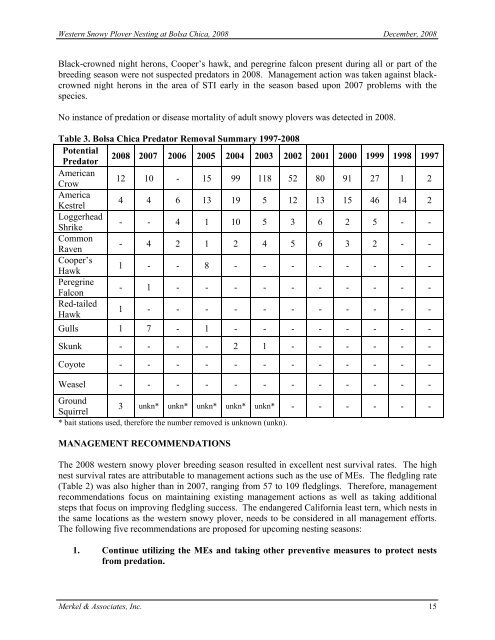2008 Annual Monitoring Report (pdf 10.9MB) - Bolsa Chica ...
2008 Annual Monitoring Report (pdf 10.9MB) - Bolsa Chica ...
2008 Annual Monitoring Report (pdf 10.9MB) - Bolsa Chica ...
You also want an ePaper? Increase the reach of your titles
YUMPU automatically turns print PDFs into web optimized ePapers that Google loves.
Western Snowy Plover Nesting at <strong>Bolsa</strong> <strong>Chica</strong>, <strong>2008</strong> December, <strong>2008</strong><br />
Black-crowned night herons, Cooper’s hawk, and peregrine falcon present during all or part of the<br />
breeding season were not suspected predators in <strong>2008</strong>. Management action was taken against blackcrowned<br />
night herons in the area of STI early in the season based upon 2007 problems with the<br />
species.<br />
No instance of predation or disease mortality of adult snowy plovers was detected in <strong>2008</strong>.<br />
Table 3. <strong>Bolsa</strong> <strong>Chica</strong> Predator Removal Summary 1997-<strong>2008</strong><br />
Potential<br />
Predator<br />
<strong>2008</strong> 2007 2006 2005 2004 2003 2002 2001 2000 1999 1998 1997<br />
American<br />
Crow<br />
12 10 - 15 99 118 52 80 91 27 1 2<br />
America<br />
Kestrel<br />
4 4 6 13 19 5 12 13 15 46 14 2<br />
Loggerhead<br />
Shrike<br />
- - 4 1 10 5 3 6 2 5 - -<br />
Common<br />
Raven<br />
- 4 2 1 2 4 5 6 3 2 - -<br />
Cooper’s<br />
Hawk<br />
1 - - 8 - - - - - - - -<br />
Peregrine<br />
Falcon<br />
- 1 - - - - - - - - - -<br />
Red-tailed<br />
Hawk<br />
1 - - - - - - - - - - -<br />
Gulls 1 7 - 1 - - - - - - - -<br />
Skunk - - - - 2 1 - - - - - -<br />
Coyote - - - - - - - - - - - -<br />
Weasel - - - - - - - - - - - -<br />
Ground<br />
3 unkn* unkn* unkn* unkn* unkn* - - - - - -<br />
Squirrel<br />
* bait stations used, therefore the number removed is unknown (unkn).<br />
MANAGEMENT RECOMMENDATIONS<br />
The <strong>2008</strong> western snowy plover breeding season resulted in excellent nest survival rates. The high<br />
nest survival rates are attributable to management actions such as the use of MEs. The fledgling rate<br />
(Table 2) was also higher than in 2007, ranging from 57 to 109 fledglings. Therefore, management<br />
recommendations focus on maintaining existing management actions as well as taking additional<br />
steps that focus on improving fledgling success. The endangered California least tern, which nests in<br />
the same locations as the western snowy plover, needs to be considered in all management efforts.<br />
The following five recommendations are proposed for upcoming nesting seasons:<br />
1. Continue utilizing the MEs and taking other preventive measures to protect nests<br />
from predation.<br />
Merkel & Associates, Inc. 15






